Is Mekong Delta Worth Visiting in Vietnam? It is a common question that tourists ask when traveling to Vietnam. It is argued that the Mekong Delta is a vast wetland with little things to discover; however, this area brings many things more enjoyable than expected. Mekong Delta is known for its beautiful natural landscape, tropical orchard gardens, lush wet rice fields, and hospitable and friendly locals.
Are you planning a trip to Vietnam and still wondering if the Mekong Delta is worth visiting? In this article, we will explore the wonders of this region and help you decide if it’s a suitable destination for your next vacation.
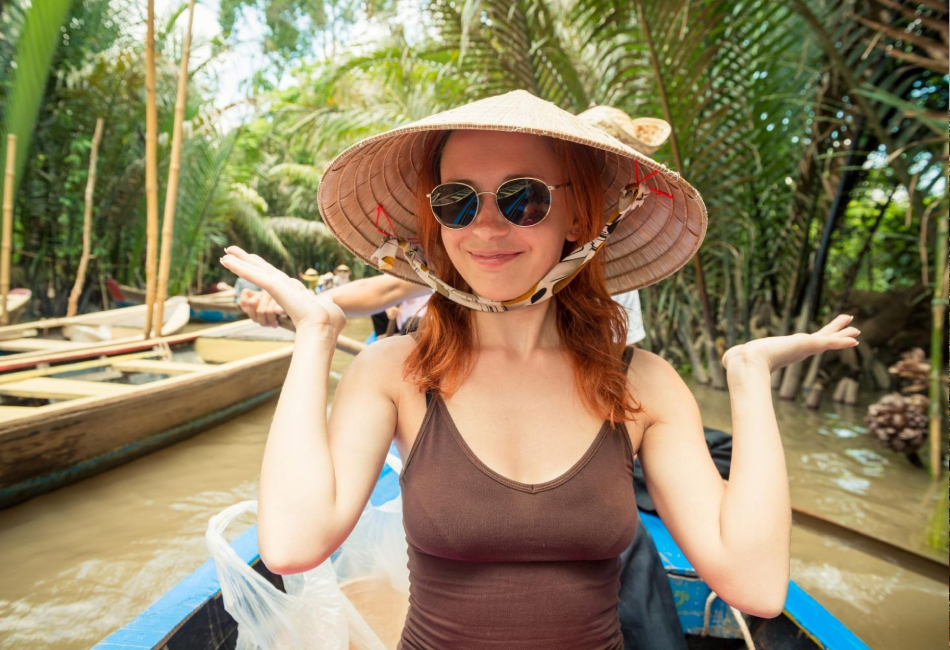

Show table of content
- 1. Overview Mekong Delta
- 2. The Geography and Weather of Mekong Delta
- 2.1 Mekong Delta Location
- 2.2 Mekong Delta weather
- 2.3 Best Time To Visit Mekong Delta in Vietnam
- 3. Things to do in Mekong Delta
- 3.1 Exploring the Floating Markets
- 3.2 Visit the Rice Fields
- 3.3 Experience Local Culture
- 3.4 Explore the Waterways
- 3.5 Visit Tan Lap Village
- 3.6 Explore Sam Mountain in Chau Doc Town
- 4. Why Mekong Delta is Worth Visiting?
- 4.1 Natural Beauty
- 4.2 Unique Culture
- 4.3 Delicious Food
- 4.4 Authentic Experience
1. Overview Mekong Delta
Mekong Delta, also known as the “No.1 rice bowl of Vietnam,” is a vast network of rivers and canals in the southern part of the country. This region, known as West Vietnam, includes one city and twelve provinces. It covers an area of 40,500 square kilometers and is home to over 17 million people. The region is famous for its vibrant floating markets, lush green wet rice fields, unique cuisine, and idyllic life.
How to get to the Mekong Delta? Most tourists come with Mekong Delta from Ho Chi Minh City or Cambodia by typical means of transportation, including airplanes, buses, or even motorbikes. Mekong Delta has only one airport, Can Tho International Airport. This airport has connected to other cities in Vietnam, including Hanoi, Halong, Da Nang, and Phu Quoc. You can take a car or bus from the airport to travel to other destinations in Mekong Delta.


2. The Geography and Weather of Mekong Delta
2.1 Mekong Delta Location
The geography of the Mekong Delta is relatively particular. Mekong Delta is located in the southwestern part of Vietnam and has a border with Cambodia to the North, Thailand to the Southwest, and the South China Sea to the Southeast. The Mekong River transports alluvium from upstream of the river along the water to deposit and establish Mekong Delta. The Mekong River runs from Tibet, Laos, Thailand, Myanmar, and Cambodia to Vietnam. The river flows into the delta, creating a vast network of channels and canals for transportation, agriculture, fisheries, and aquaculture.
2.2 Mekong Delta weather
The weather of the Mekong Delta is one of the primal factors that visitors consider when traveling here. Mekong Delta has a tropical monsoon climate with two primary seasons. In general, the dry season is from November to April. April is the hottest month, with temperatures about 93°F (33,9°C). December to January is chiller compared to other months. February is the best time to visit Mekong Delta and engage in outdoor activities with the least rainfall. The rainy season is from May to the end of October. The unexpected shower often occurs in the late afternoon and lasts 1 to 2 hours, so it would not interfere much with your itinerary. The early wet season would begin the hottest period of the year.
For details about the Mekong Delta weather, visit our Vietnam Weather Overview for more helpful information.


2.3 Best Time To Visit Mekong Delta in Vietnam
As mentioned above, February is the best time to visit the Mekong Delta for the most pleasant and rarely rain. Especially Tet Festival (Lunar New Year) also takes place during this time, often from the last week of January or the 2nd week of February. Therefore, you can engage in festival activities without worrying about weather issues.
Another time you must visit Mekong Delta is the “floating season”. It takes place annually from August to October. During this time, floodwater carries a massive amount of alluvial to the farmland and provides a lot of aquatic species. The floating season is a unique character of the river region. All local’s activities are connected with floodwater and idyllic boat, and people use boats as their houses.
Coming to Mekong Delta in the floating season, you can encounter simple moments like locals eating in a hurry to catch fisheries. Imagine you are sitting on a boat and enjoying the rich flavor of the West region with a bowl of tasty Hu Tieu, the sweetness of a piece of Panda Rice Cake, or the bitterness of a cup of black coffee; you will be captivated by the rustic flavor of the Mekong Delta in the floating season.
Exploring Mekong Delta during the floating season is highly recommended for anyone seeking to immerse themselves in the exciting activities that make this unique river region.


3. Things to do in Mekong Delta – Is Mekong Delta Worth Visiting?
Mekong Delta is a unique and diverse region in Vietnam, offering travelers various activities to experience the typical life of the land of river and water. Here are some of the best things to do in the Mekong Delta:
3.1 Exploring the Floating Markets
The Mekong Delta is a vast wetland area; therefore, the floating market formed from trading goods of locals in the river. Floating markets are different from the traditional market in Vietnam in terms of modes of purchase and means of transportation. Floating markets often gather at river confluences. It is a place where the river is not too broad and too deep, convenient for anchoring boats. The floating market opens at 4 am and ends at 9 am. People go to the market by boat, buy and sell, and exchange products, food, and other essential goods on the river. Sellers often put a simple stick on the boat’s bow and hag their goods in the stick to buyers realize and come.
Except for the large boat, which often sells tropical fruits and vegetables, the smaller boat provides everything from local food, snacks, coffee, souvenirs, handicrafts, and so on. Exploring the Floating Markets is a perfect way to discover the diverse and idyllic local life here. Visiting a floating market is not only about shopping; it’s also an opportunity to release yourself in local culture. You can observe the daily routines of people living along the waterways, interact with friendly locals, and enjoy traditional Vietnamese dishes and snacks sold on boats. Some must-visit floating markets in West Vietnam include Cai Rang Floating Market in Can Tho, Nga Nam Floating Market in Soc Trang, Tra On Floating Market in Vinh Long, and Chau Doc Floating Market in An Giang, and more.
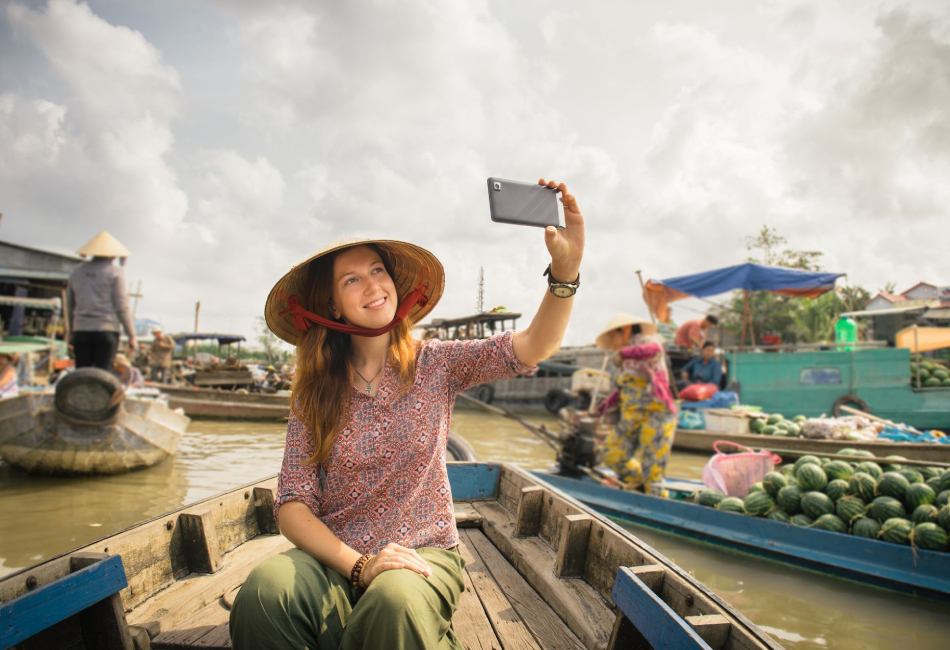

3.2 Visit the Rice Fields
Mekong Delta is Vietnam’s most significant agricultural production area and is known as the No.1 rice bowl in Vietnam. Therefore, when it comes to this area, remember to visit the rice fields here. Mekong Delta is famous for its lush green rice fields stretching as far as the eye can see. Visitors can take a bike tour or a boat ride to explore the countryside and learn about the rice farming process. The best time to visit the rice fields is during the harvest season, June to November.
Mekong Delta has much lush rice fields with picturesque scenery for visitors to enjoy the serene atmosphere in the countryside, including rice fields in Hau Giang, Ca Mau, or Can Tho. Ta Pa Rice Fields is one of the most stunning rice fields in the Mekong Delta, attracting visitors year around for its unique fields. This rice field is at the foot of Ta Pa and Co To mountains in An Giang province. According to the locals, the most vibrant rice fields fall from September to early November, breathtakingly combining yellow and green in the harvest season.
3.3 Experience Local Culture
Visitors can experience local culture by visiting traditional villages, trying local foods, and attending cultural festivals. The culture of the Mekong people attaches to the river. In the past, when land transportation was not developed, the boat was the primary vehicle everybody must have to commute around the village. Despite the modernization of land transportation, the locals still use rustic crafts for traveling in their area. Therefore, when you visit this charming land, remember to take a boat, wave through the bunch of water hyacinths floating on the river and explore the authentic river region.
Some of the most popular festivals in the region are the Chua Xu Temple Festival, known as the worshipping goddess festival. This festival is held from the 23rd to the 27th day of the fourth lunar month in Ba Chua Temple at Sam Mountain, An Giang Province. Another important festival is the Ok Om Bok Festival, known as the Festival of Worshipping the Moon. The festival is held around the full moon of the 10th month of the lunar calendar every year in Soc Trang province. Tourists can witness boat racing and other awesome cultural activities during the vibrant festival.
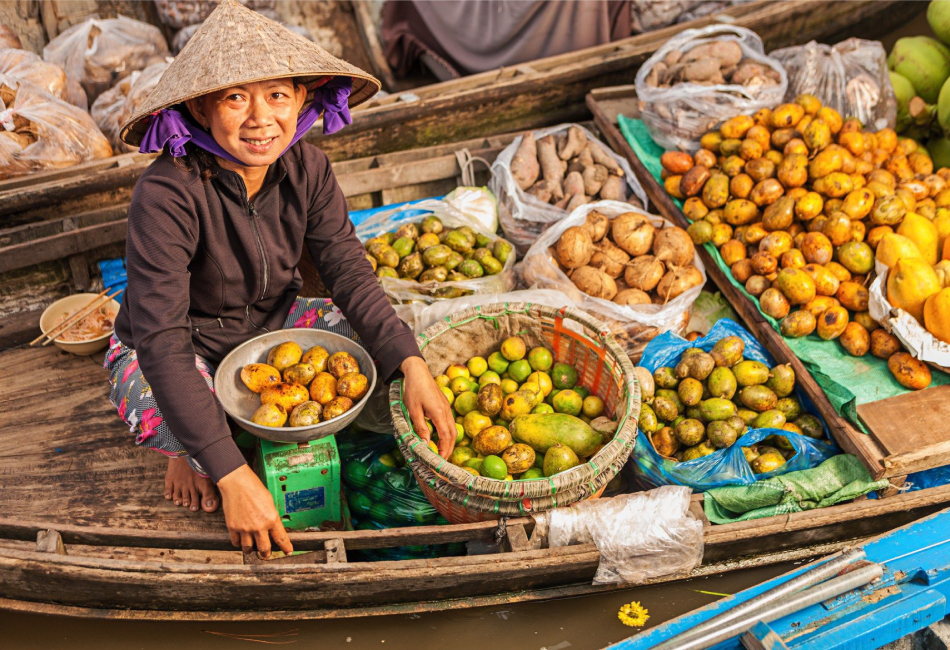

3.4 Explore the Waterways
Mekong Delta is a vast network of rivers and canals, making it an ideal destination for boat tours. Visitors can take Mekong Delta Cruise along the Mekong River, explore the narrow channels, and visit small villages and tropical orchards. Another way to explore the waterways and enjoy the beautiful landscape of the river region is to experience a cruise at Ninh Kieu Wharf. Cruises usually operate from 7:30 P.M. to 9 P.M. daily to serve tourists to visit, experience, savor fresh seafood, and thoroughly enjoy the beautiful scenery of Ninh Kieu Pier at night.
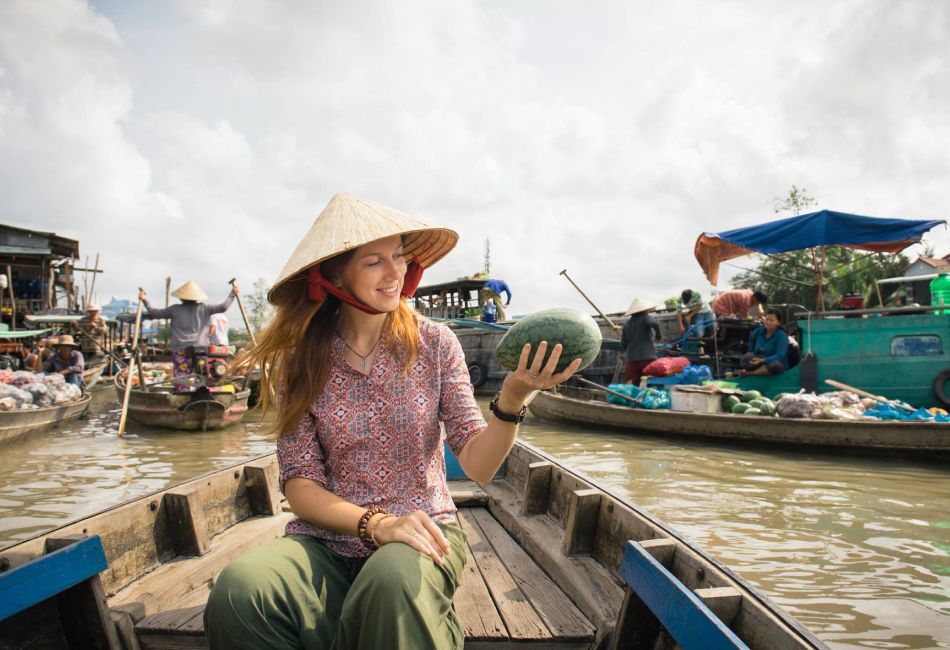

3.5 Visit Tan Lap Village
Tan Lap Floating Village is located in the center of Dong Thap Muoi. This floating village eco-tourism site is in Moc Hoa District, Long An Province. Visiting the Tan Lap Village, you can release yourself in the stunning nature of the West Vietnam River. The tourist area includes the park, hotels, and wharf areas. A rowing boat is ideal for exploring the village. The boatman is a friendly guide, taking you to creep into the serene swamps and discover the diverse ecosystem here. Another way to visit the Tan Lap Floating Village is by walking through the lush green of Melaleuca Forest, enjoying the peaceful atmosphere and charming color of water lilies. In addition, you can savor West cuisine at the floating village, with rustic ingredients but an unforgettable bold flavor.
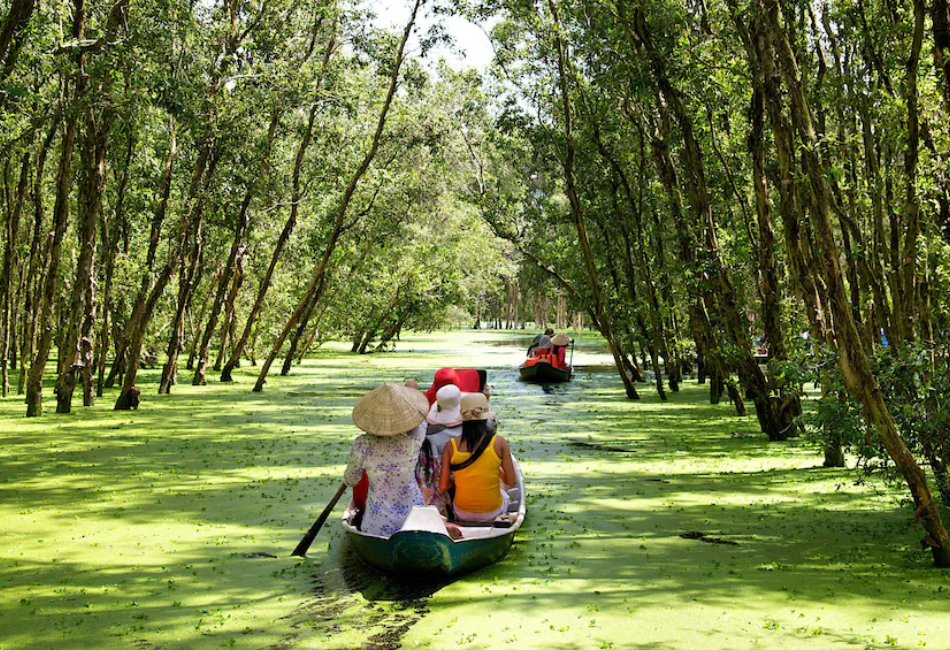

3.6 Explore Sam Mountain in Chau Doc Town
Sam Mountain is located in An Giang Province at a high of 284m above sea level. It has about 200 temples, pagodas, and shrines scattered from the foot to the top of the mountains. It is impossible not to mention the Ba Chua Xu Temple, Tay An Pagoda, and Thoai Ngoc Hau Tomb for the people exploring the spiritual beauty of the Mekong Delta. Also, summer is the best time to visit Sam Mountain as the phoenix is stunningly blooming on the mountains’ roads. Bring snacks like fruit and water to ensure your health if you visit Sam Mountain. A trip to Sam Mountain will be a perfect choice if you are looking for an attractive spiritual tourist destination and enjoying the fresh air.


4. Why Mekong Delta is Worth Visiting?
The Mekong Delta holds a plethora of reasons why it should be on every traveler’s bucket list. From its breathtaking natural beauty to its unique cultural heritage, delightful cuisine, and authentic experiences, the Mekong Delta offers an unforgettable journey that promises to leave an indelible mark on anyone fortunate enough to explore its wonders.
4.1 Natural Beauty
The Mekong Delta is a paradise of lush landscapes, where the intricate interplay between land and water creates a mesmerizing tableau. As the mighty Mekong River fans out into a network of channels and tributaries, it gives rise to a stunning picture of rice paddies, fruit orchards, diverse mangrove forests, and vibrant floating markets. Travelers are admired captivating scenes of traditional wooden boats paddling gracefully on the water, covered by jade water lily pads and blue skies. The region’s unique topography and vibrant ecosystem make it a haven for nature enthusiasts and photographers seeking to capture its natural beauty.
If you are a nature lover and want to experience new surprises from nature, national parks and reserves in the Mekong Delta are exciting suggestions for you. Mekong Delta also is home to many national parks and natural resources in Vietnam. It is only possible to mention Tram Chim National Park in Dong Thap province. It has more than 200 rare bird species, especially the red-crowned crane. Also, Ca Mau Cape National Park in Ca Mau province. It was honored to be recognized by UNESCO as a world biosphere reserve in 2009. It has a diverse ecosystem, especially the flora and fauna of the mangrove forest. Moreover, remember to visit Dong Thap Muoi Ecological Reserve in Tien Giang Province and Lung Ngoc Hoang Nature Reserve in Hau Giang Province.


4.2 Unique Culture
Mekong Delta has diverse ethnic groups, including Vietnamese, Khmer, Cham, and Chinese, with unique cultures and traditions. Visitors can experience local life and learn about the customs and traditions of the region. Visitors can immerse themselves in the daily lives of locals, witnessing age-old customs, intricate handicrafts, and colorful festivals that celebrate the area’s heritage. Whether visiting the Floating Market or partaking in a homestay with a local family, travelers are bound to make meaningful connections with the warm and hospitable people of the Mekong Delta. Especially locals always have a friendly smile on their face. Tourists can enjoy the unique culture in Mekong Delta without the gap between ethnicity, culture, and languages.


4.3 Delicious Food
Every visit to the Mekong Delta is complete with indulging in its mouthwatering culinary offerings. Renowned for its fresh and flavorful dishes, the region’s cuisine showcases a harmonious blend of ingredients sourced from both land and water. From savory dishes like “Banh Xeo” (crispy pancakes), “Banh Khot” (Mini rice pancakes), and “Bun Mam” (fermented fish noodle soup) to the iconic “Hu Tieu” (noodle soup), every bite is a compelling journey into the heart of Vietnamese food lovers. Travelers can explore local markets, engage in cooking classes, and savor the distinctive flavors reflecting the delta’s bounty’s fertile lands and bountiful waters.
Apart from the traditional cuisine above, Mekong Delta has a specialty in Ben Tre Province that tourists will get scared of when they see it for the first time. It is “Đuông dừa” (coconut weevil), a larvae of the beatless. The characteristic of this type of larvae is that they often lay eggs in fresh green coconut trees, choosing the location of the tree top to make a hole for shelter. Gradually, thanks to the absorption of nutrients by the coconut totem, the larvae developed.
Coconut weevil is considered a specialty dish of the Mekong Delta, with this land’s distinctive and characteristic features. Coconut worm is clean and greasy because it absorbs the freshest part of the coconut tree. The coconut weevil resembles a worm with a soft body and wiggling on the plate. Therefore, those who see it for the first time will be scared and do not dare eat. However, it is better than you think: try it once when you come to Ben Tre.
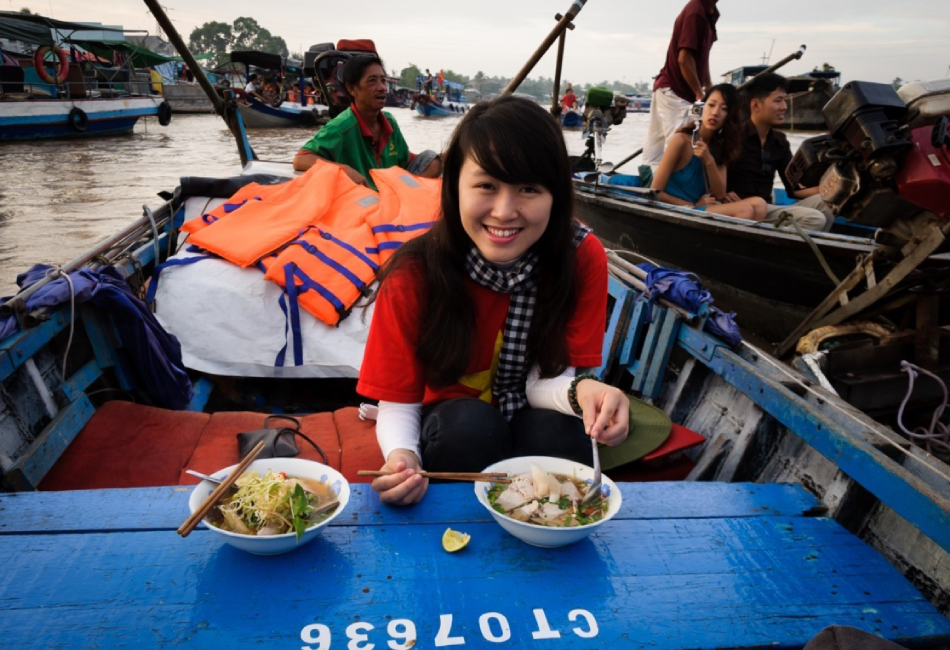

4.4 Authentic Experience
The Mekong Delta is still largely untouched by mass tourism, making it an ideal destination for those seeking an authentic travel experience. One of the most compelling reasons to visit the Mekong Delta is the opportunity to engage in authentic experiences that immerse travelers in the material of local life. From cycling through tranquil villages and observing age-old fishing techniques to participating in traditional ceremonies and exploring bustling markets, every moment is a chance to gain insights into the region’s uniqueness. Visitors can better understand the Mekong Delta’s history, livelihoods, and cultural significance by interacting with locals. One of the exciting experiences visitors can join is harvesting rice and water lilies, wading in mud, to catching fish with locals.
With its captivating natural beauty, vibrant culture, and mouthwatering cuisine, this enchanting is genuinely worthwhile for tourists who want to explore the river region in Vietnam. Whether it’s crossing its picturesque landscapes or connections with its friendly locals, a visit to the Mekong Delta is a perfect choice for the journey to discover the vibrant culture of Vietnam.


0 Comment